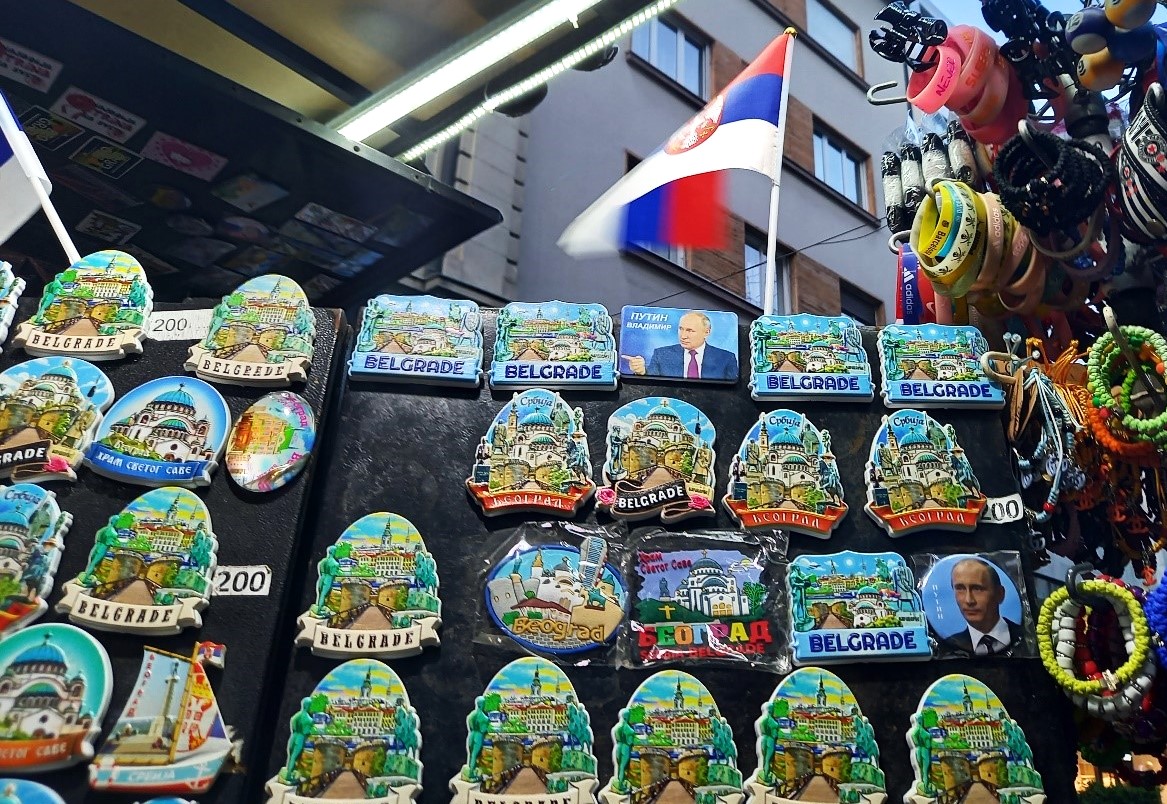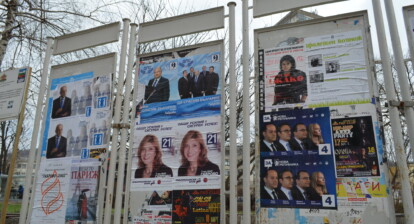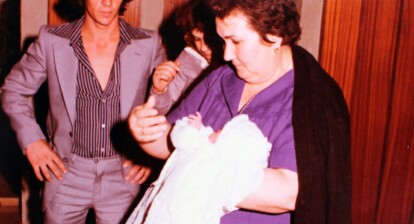From the hippie movement during the 1960s to the recent Fridays for Future protests all over Europe: the youth has traditionally been a driving force for change. But in Serbia nowadays, a phenomenon in terms of contrary tendencies is occuring. This phenomenon, as one problematic in Serbian society, seems to be the result of disdain felt by members of all generations towards “Western” values. Petar from Belgrade examines the driving force behind these conservative tendencies towards Nationalism in Serbia. Can they be reversed?
What image do you form inside your mind when picturing a young person? Cheerful, wearing brightly coloured clothes, enthusiastic about meeting new people and generally open to new things? One would usually imagine younger people as more liberal and progressive than their parents.
An Uncomfortable Past and an Uncertain Future
The Serbian youth lives under challenging circumstances. The Yugoslav Wars of the 90s, marked by sanctions, bloodshed, and societal and economic regression, resulted in a referendum. In this referendum, Montenegro chose to depart from the then-existing Federal Republic of Yugoslavia (not the original socialist one but rather what remained of it). This decision led to the formation of the modern state of Serbia in 2006. Serbia quickly recognized that a membership in the European Union offered the best path to achieve peace and prosperity.
Between Russia and the EU
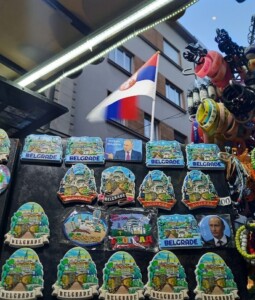
Russia’s president Vladimir Putin in line with traditional magnets in Belgrade (Photo: private).
However, slow progress ensued due to the enduring political structures of Milosevic’s nationalist regime. Consequently, Serbia only obtained EU candidate status in 2012 and has made minimal progress since. Moreover, Serbia recently halted the process because it refused to impose sanctions on Russia. A walk down Belgrade’s main Knez Mihailova street reveals some more.
It shows the confusing political situation the country finds itself in today: In souvenir shops, magnets showing Serbian landscapes line up with those portraying Russia’s president Vladimir Putin.
A Eurosceptic Youth
As the process of Serbia’s accession to the EU is slowing, enthusiasm for it is also dwindling. What may come across as surprising is just how undecided the youth is towards euro-integration. Indeed there are many opportunities such as the Erasmus+ exchange program or open borders within EU countries. But still, a staggering 46 per cent of Serbia’s youth is against the EU accession. This number has been rising in recent years. With the bloody past stoking nationalism and the pessimistic present of Eurocepticism, what else influences the minds of the youth? I asked my friend Stefan (22) from Belgrade for his opinion regarding youth culture in Serbia.
Serbia’s Youth: Caught in Trauma and Fear?
“I believe that Serbia and the youth from the Balkans suffer a multigenerational trauma left by the wars and as a consequence of living under authoritarian regimes. Unfortunately, that has cultivated a culture of fear amongst the youth of expressing their opinions, and it hinders self-expression. Self-expression is typically frowned upon in this culture of fear. Growing up in Serbia, I was never encouraged to do any critical thinking regarding group thinking and personal identity. Instead, one is taught never to question society and follow the rules just like everyone else.
Can Alternative Communities Beat Conservatism?
People with different individual identities receive no integration into the broader community. Their own families even marginalize them. My friends have experienced threats just for looking and dressing differently. Regressive, nationalistic and hyper-conservative thinking is even present in higher education institutions, where professors commonly push a conservative narrative and punish opposing worldviews. Expressing contrarian ideas in Serbia often results in threats to physical safety, and minorities have to be very careful in public. However, I have noticed some positive changes in the last few years, mostly in the growing alternative community in Belgrade, where pretty much everyone is welcome. Still, this community is only a fairly small part of the young population, but I’m optimistic it’ll continue to grow.”
A Heaven for Conspiracy Theories
With the advent of unrestricted and often uncensored internet access, conspiracy theories have become a massive element of public discourse globally. Initially limited to a fringe part of society, they’ve found their way to the mainstream. They now have the power to influence public opinion, as they did during the covid-19 pandemic. The lack of trust towards science is most obvious when looking at COVID-19 vaccination rates in Serbia. Only about half of eligible people got a vaccination. With even lower numbers among the country’s youth even though plenty of vaccines were available. This was because of the massive success of the anti-vax movement in Serbia, where misinformation finds a remarkably fertile ground to spread.
Isolationism – a New Old Trend?
The popularity of conspiracy theories isn’t a new trend here. It was quite common during the isolationism of the 90s to blame abstract foreign forces such as the Vatican for every trouble the people faced. This was the case because of the deep ethnic background of the Yugoslav conflicts, as well as a sense of resentment toward the rest of the world due to sanctions. The trend persisted, and even today, state-aligned media often mention people as the ones to blame for the country’s internal issues.
State Propaganda Meets Graffiti
When it comes to the country’s youth, the impact of state propaganda and national myths is key to understanding why so many young people have extremely anti-western political views. The Kosovo issue’ importance is propped up in many textbooks, on walls in the form of repetitive graffiti, and in the public discourse. Hatred towards former adversaries of Serbia in the wars of the 90’s, such as Croatia and Albania, is not dwindling at all, and children sometimes sing songs glorifying war crimes. Populism is not a new trend in the country, and it seems that it is now stronger than ever.
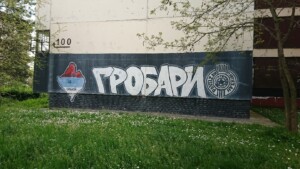
A frequent nationalist-hooligan graffiti reads “Kosovo is Serbia” next to the club’s logo and hooligan group name. (Photo: private)
Impact of the Internet
However, the impact of certain websites and YouTube channels, such as Balkan info or Slavija info can’t be overstated. They have become the centre of many jokes because of their outlandish guests (often veterans from the 90’s wars) who theorize about the impact of aliens and demons on world politics. The videos quite often feature how Western governments plan the total enslavement and murder of the world’s population, especially Serbia’s. Or how Russia is waging its war in Ukraine for the good of all mankind – a holy war of sorts. These channels have an alarming influence on public discourse and have millions of views in a country of less than 7 million people. In the meantime, national newspapers like Srpski Telegraf tend to publish anti-EU articles blaming the European Union to destroy Serbia.
Be a Man and Love Football!
More and more Serbians show little tolerance towards anything that gets close to an alternative lifestyle. It’s one of the most noticeable things while being a youth in Serbia. Growing up as a boy means that from a very young age, one must first choose their favourite football club. There are one of two options: FK Crvena Zvezda (Red Star) or FK Partizan (Partisan). Of course, I also had to pick a team. As someone with no interest in football and only had a moderate interest as a child, I chose randomly. The names of these two clubs may seem ironic as they were created during Yugoslav socialist times. But now the clubs mostly attract hooligans. There is a close link between the football and gang culture. Young men often find themselves in hooligan groups, based on where they grew up. One neighbourhood supports Red Star while another supports Partisan.
A Culture of Groupthink
Groupthink is also all-encompassing. Individuals with any unusual clothing or other preferenceres, such as long hair, experience isolation and marginalization. Not adhering to the one-dimensional nationalist rhetoric often leaves young people outside the group. Even those who are of a slightly different opinion. They have to simply give up on self-expression. Or they blend in to avoid being seen as “enemies” or at least “different” of sorts. This often ment giving up on interests or hobbies that don’t align with what your friends like. As a child, my interests were plants and animals. But after a time, I had to shift my focus to football clubs and nationalist things to socialize.
Facing the Culture
Tara (18) from Belgrade also has a critical stance towards the dominant culture:
“Growing up in Serbia, in almost every case, means being exposed to orthodox nationalist contents via media or socialization, which are regarded as an expression of benevolent patriotism and a way of preserving cultural heritage and traditional values. Having grown up in a family that leans towards pro-Western values that deviate from the hardened right-wing pattern, I have adopted behaviours and sets of ideas that are often interpreted as unfavourable to society. I think that the need to preserve nationalism is somewhat rooted in the socio-economic crisis that culminated in the 90s and which has not been resolved to this day. Combined with the lack of education and the persevering narrative of Milošević’s nationalist politics, the inability to develop a personal identity in most cases results in the glorification of Greater Serbia ideology as an alternative form of self-realization. In my opinion, mostly individuals adopt the pro-nationalist narrative who consider themselves inferior. Therefore, inapt to set and achieve their own goals. Instead, they gravitate towards violent groups within which they seemingly strengthen the integrity of their personality. This feeling of inferiority stems from the socioeconomic status and level of education, which, due to the still relevant economic crisis, hinders many individuals from self-acceptance and forms a sense of inability to contribute to improving society. A feeling of inadequacy and hopelessness thus often helps this culture thrive among young people.”
Optimism in the Face of Reality
Despite all, change is possible. Even though the current cultural nationalist landscape can cause a lot of disappointment for people with non-typical worldviews, things are changing. There is a growing share of young people who are very open-minded and liberal in their worldviews. Certain positive changes can, at times, be felt in the energy of the youth. But unfortunately, these changes are easily drowned out by the still relentless narrative of the majority. Extremists are getting a place in the spotlight in the face of current events such as Russia’s war in Ukraine and renewed tensions in Kosovo. I still think, however that positive change is possible. Those who see issues should always strive to help fix them. Remaining hopeful that Serbia’s youth will create a brighter, more tolerant and progressive future. With a growing tension present between the dominant, conservative “gaser” group and an emerging colourful alternative and liberal youth, it will be interesting to see if and how the youth culture changes. Perhaps in the future, when one imagines a young person in Serbia, it will be a progressive, open and colourful one.

